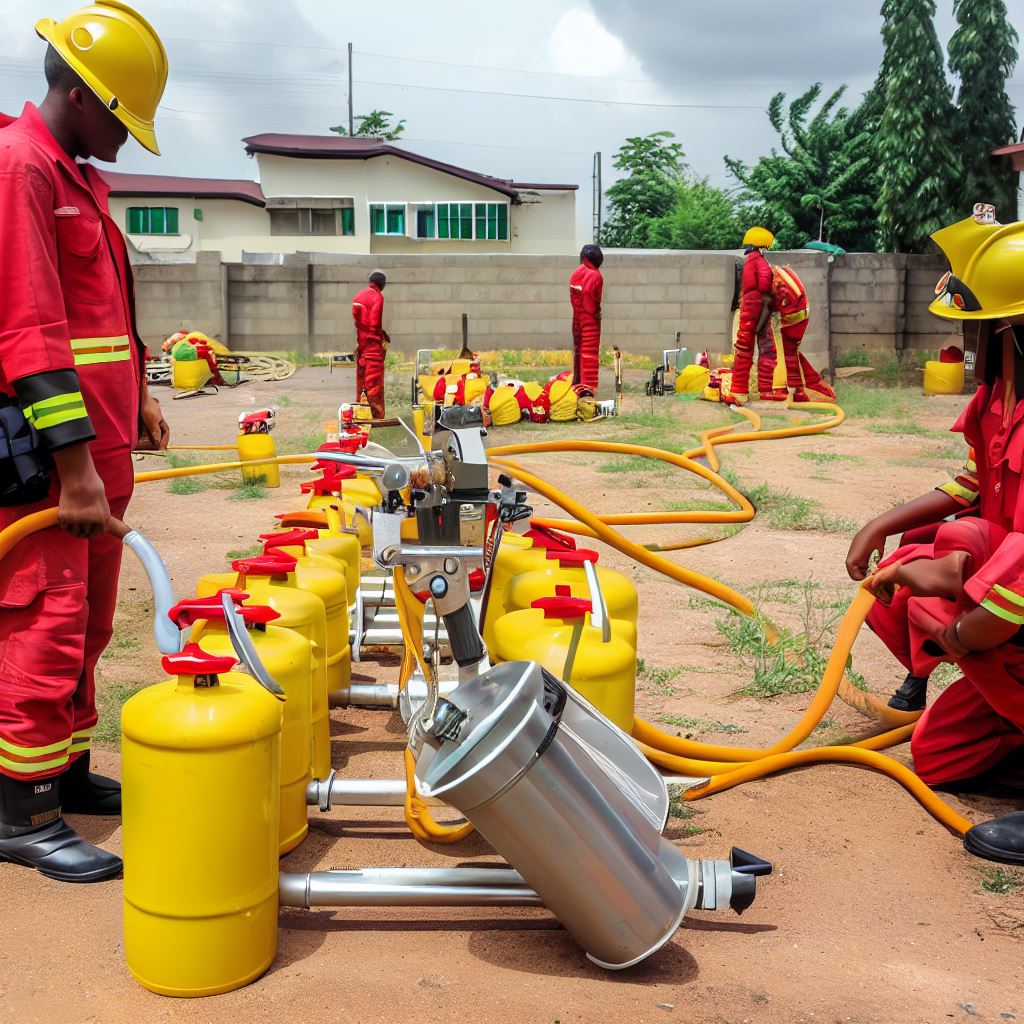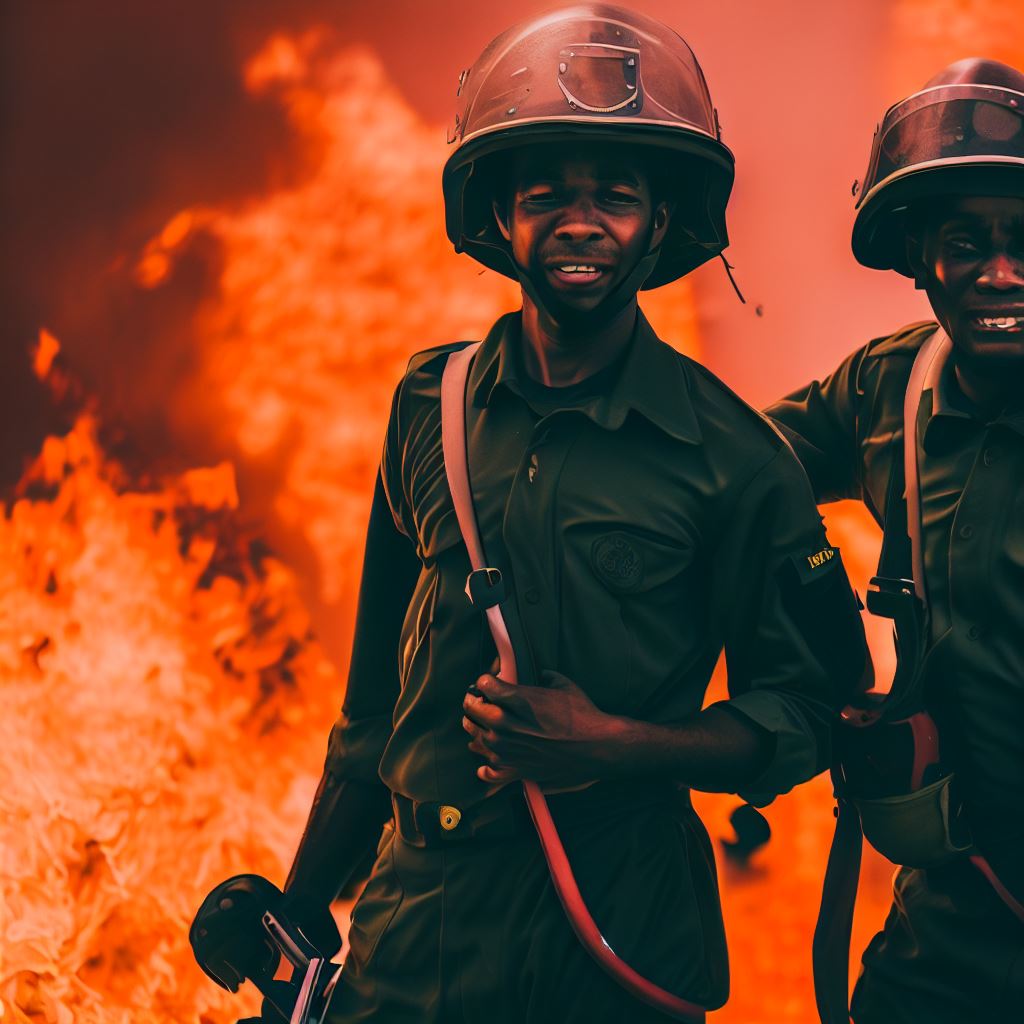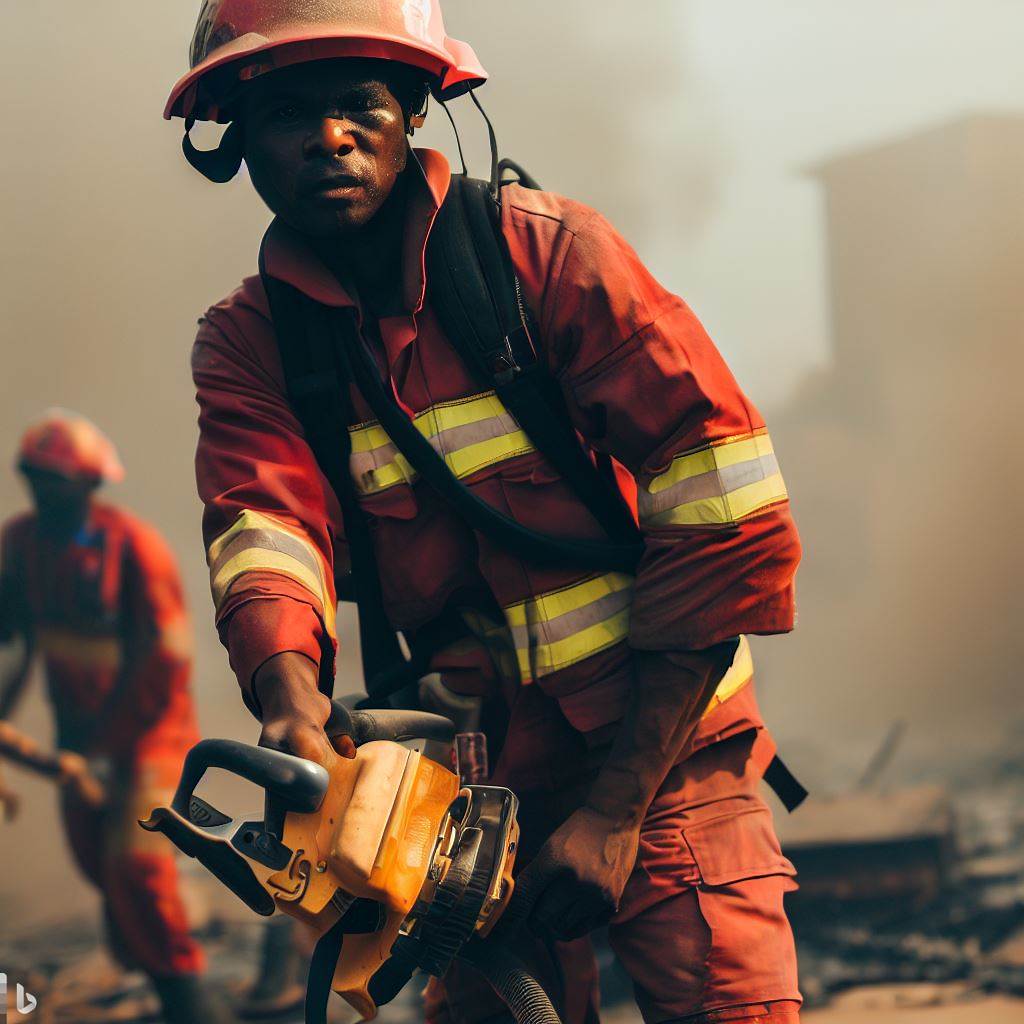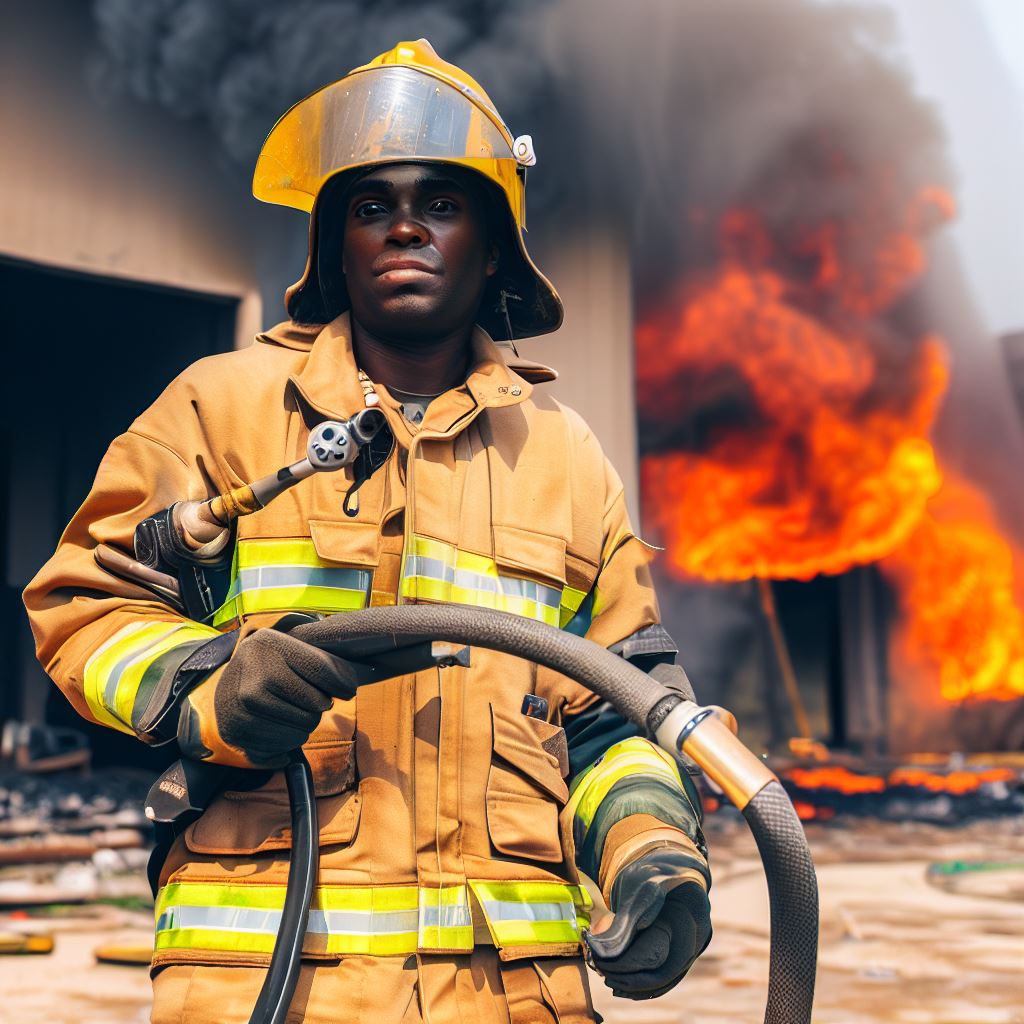Introduction
Firefighting equipment plays a critical role in safeguarding lives and property in Nigeria, a country prone to various fire hazards.
These hazards can occur in residential, commercial, and industrial settings, making the presence of effective firefighting equipment necessary to minimize the potential damage.
Equipping Nigerian firefighters with state-of-the-art tools and technologies ensures enhanced response capabilities and increases the chances of successful firefighting operations.
In this blog post, we will delve into the top firefighting equipment utilized in Nigeria today.
By understanding the importance of these tools and their functionalities, we can appreciate the efforts made to combat fires effectively.
From fire engines equipped with water cannons to high-quality protective gear like fire-resistant clothing and helmets, Nigeria has seen significant advancements in its firefighting capabilities.
Additionally, we will explore various types of extinguishers, such as foam, powder, and carbon dioxide, that are utilized based on the nature of the fire.
Furthermore, modern technologies like infrared scanners and thermal imaging cameras aid in identifying hidden heat sources and assessing the fire’s spread.
Overall, the proper utilization of firefighting equipment in Nigeria is crucial for swift and effective responses to fire emergencies.
This blog post aims to shed light on the significance of these tools and highlight the advancements made in firefighting techniques, ultimately contributing to a safer environment for all Nigerian residents.
Stay tuned for an in-depth look at the top firefighting equipment used in Nigeria today.
Fire Extinguishers
Types of fire extinguishers commonly used in Nigeria
- Water extinguishers: These use water to cool down the fire and extinguish it.
- Foam extinguishers: Foam forms a layer over the fire, cutting off its oxygen supply.
- Carbon dioxide (CO2) extinguishers: These contain CO2 gas, which removes oxygen and suffocates the fire.
- Dry chemical powder extinguishers: These are versatile and can tackle different types of fires.
Uses and effectiveness of each type
Water extinguishers are effective for fires involving wood, paper, and textiles. However, they should not be used for electrical or flammable liquid fires.
Foam extinguishers work well on flammable liquid fires and are also safe to use on electrical fires.
They create a floating blanket that seals the fire’s surface and prevents re-ignition.
Carbon dioxide extinguishers are ideal for electrical fires, as they do not leave any residue.
They are also effective for flammable liquid fires, but not suitable for fires involving combustible metals.
Dry chemical powder extinguishers are suitable for a wide range of fires, including flammable liquids, gases, and electrical equipment fires.
They form a barrier between the fuel and the oxygen, suppressing the fire quickly.
Importance of regular maintenance and proper usage
Regular maintenance of fire extinguishers is essential for ensuring their effectiveness in emergencies.
Proper inspection includes checking the pressure gauge, ensuring the safety pin is intact, and checking for any physical damage or corrosion.
It is crucial to place fire extinguishers in easily accessible locations and educate individuals on their usage.
Training on the correct operation of fire extinguishers can prevent panic-driven mistakes during a fire emergency.
Remember to always aim at the base of the fire and use a sweeping motion while operating a fire extinguisher.
Regularly scheduled maintenance and refilling of fire extinguishers must be carried out by certified professionals.
By practicing regular maintenance and using fire extinguishers correctly, lives and property can be protected from the devastating effects of fire.
Fire Alarm Systems
Different components of a fire alarm system
- Smoke detectors: Devices that sense smoke particles in the air and trigger the alarm.
- Heat detectors: Sensitive to high temperatures, they activate the fire alarm when the temperature rises.
- Fire alarm control panel: Centralized unit that receives signals from detectors and activates alert systems.
- Notification devices: Alarms, bells, sirens, or strobe lights that warn occupants of a fire.
Overview of how fire alarm systems work to detect and alert occupants of a fire
Fire alarm systems employ a network of sensors, such as smoke and heat detectors, which continuously monitor the environment.
When smoke or high temperature is detected, the sensors send signals to the control panel, which then triggers the notification devices.
Advantages and benefits of having a well-functioning fire alarm system
- Early detection: Fire alarm systems can detect fires in their early stages, allowing for quick response and containment.
- Occupant safety: By notifying occupants immediately, fire alarm systems provide crucial time for evacuation and reduce the risk of injuries or fatalities.
- Property protection: Rapid fire detection helps minimize damage to buildings and possessions, preventing the spread of the fire.
- Automatic response: Fire alarm systems can be integrated with sprinklers and fire suppression systems, automatically activating them when necessary.
- 24/7 monitoring: Monitoring services can be connected to fire alarm systems, ensuring constant surveillance and prompt emergency response.
- Compliance with regulations: Having a well-functioning fire alarm system ensures compliance with safety codes and regulations, avoiding fines and penalties.
- Insurance benefits: Many insurance companies offer reduced premiums to properties equipped with reliable fire alarm systems.
In fact, fire alarm systems play a vital role in ensuring the safety of occupants and protecting properties from the devastating effects of fires.
By understanding the components of a fire alarm system, how they work together to detect and alert, and the advantages they offer, individuals and organizations can make informed decisions about installing and maintaining these critical life-saving devices.
Read: Fire Fighter Training: A Guide to Courses in Nigeria
Fire Sprinkler Systems
Purpose and functioning of fire sprinkler systems
Fire sprinkler systems are designed to detect and control fires in buildings. When a fire is detected, the sprinklers are activated, releasing water to extinguish the flames.
The system operates automatically, minimizing the risk of human error and enhancing fire safety.
Different types of sprinkler systems commonly used in Nigeria
- Wet pipe sprinkler systems
- Dry pipe sprinkler systems
- Pre-action sprinkler systems
- Deluge sprinkler systems
Advantages and effectiveness of fire sprinkler systems in combating fires
Fire sprinkler systems offer several advantages in fire safety:
- Immediate response: Sprinklers react quickly to a fire, minimizing the spread of flames and reducing potential damage.
- Continuous protection: Fire sprinklers operate 24/7, providing constant protection even when the building is unoccupied.
- Individual activation: Each sprinkler head operates independently, ensuring targeted response and avoiding unnecessary water discharge.
- Reduced water damage: Sprinklers activate early, using smaller amounts of water compared to firefighting hose streams, which minimizes water damage.
- Cost-effective: The cost of installing fire sprinkler systems is relatively low compared to potential fire-related losses and property damage.
In Nigeria, fire sprinkler systems have proven to be highly effective in combating fires.
They have saved lives and prevented substantial property damage in various commercial buildings, industries, and residential premises.
Their quick response and ability to control fires until firefighting personnel arrive make them a reliable fire safety measure.
To conclude, fire sprinkler systems are vital components of fire safety infrastructure.
With their different types and advantages, they provide effective protection against fires in Nigeria and contribute significantly to saving lives and minimizing property damage.
Installing and maintaining these systems is a crucial step in ensuring the safety of buildings and their occupants.
Read: Challenges and Triumphs: Fire Fighting in Nigeria

Explore Further: COVID-19’s Impact on Event Management in Nigeria
Fire Hydrants and Hoses
Overview of the Importance of Fire Hydrants in Fire Fighting
Fire hydrants play a crucial role in efficient fire suppression operations.
They provide a readily available water source for firefighters, enabling them to quickly extinguish fires and save lives and property.
- Reliable Water Supply: Fire hydrants are connected to the water distribution system and provide a constant and reliable water supply to firefighters.
- Rapid Water Access: With their prominent location in urban areas, fire hydrants allow firefighters to quickly access water, minimizing response time and preventing the fire from spreading further.
- Increased Firefighting Capacity: Fire hydrants enable firefighters to connect their hoses directly to the water source, enhancing their firefighting capacity. This allows them to tackle larger fires effectively.
- Accessibility: Fire hydrants are strategically installed throughout cities and communities, ensuring accessibility and coverage across different areas. This accessibility is vital since fires can occur anywhere at any time.
How Fire Hydrants Work and Their Components
Fire hydrants work based on a system of valves and pipes, designed to provide a controlled water supply during firefighting operations.
- Underground Water Supply: Fire hydrants are connected to underground water mains, which are part of the municipal water supply network.
- Valve Operation: Fire hydrants have a valve system controlled by a wrench-like tool. This valve controls the water flow into the fire hydrant.
- Water Distribution: When the valve is opened, water flows from the underground mains through the hydrant and into the fire hoses used by firefighters.
- Components: Fire hydrants consist of various components, including the bonnet, valve stem, main valve, hydrant body, and outlet.
Usage of Fire Hoses and Their Role in Fire Suppression
Fire hoses are essential tools in fire suppression, allowing firefighters to effectively control and extinguish fires.
- Water Delivery: Fire hoses deliver a high-pressure stream of water to the fire, smothering the flames and cooling the surrounding area.
- Versatility: Fire hoses come in various sizes and lengths, allowing firefighters to adapt their usage based on the fire’s intensity and reach.
- Firefighting Techniques: Fire hoses are used in different firefighting techniques, such as direct attack, indirect attack, and exposure protection.
- Equipment Compatibility: Fire hoses are designed to connect seamlessly with fire hydrants, providing a continuous water supply during firefighting operations.
- Safety Measures: Fire hoses are manufactured to withstand high pressure and extreme heat, ensuring the safety of firefighters during fire suppression activities.
- Training and Handling: Firefighters undergo extensive training on how to properly handle and operate fire hoses to maximize their efficiency and ensure effective fire suppression.
- Regular Maintenance: Fire hoses require regular inspection and maintenance to ensure their reliability and functionality during emergencies.
In short, fire hydrants and hoses are essential components of fire fighting equipment in Nigeria.
Fire hydrants provide access to a reliable water supply, while fire hoses enable firefighters to deliver water effectively to extinguish fires.
Their proper usage and maintenance are crucial in successful fire suppression operations, ultimately saving lives and protecting property.
Read: The History of Fire Fighting in Nigeria: A Brief Look
Personal Protective Equipment (PPE)
Introduction to the concept of PPE in fire fighting
Personal Protective Equipment (PPE) is a crucial element in fire fighting as it provides safety and protection to firefighters during emergency situations.
Different types of PPE used by fire fighters in Nigeria
- Fire-resistant clothing
- Helmets and face shields
- Gloves and boots
- Breathing apparatus
Importance of wearing proper PPE for firefighter safety
Wearing proper PPE is of utmost importance for firefighter safety in Nigeria.
Here’s why:
- Protection against external hazards
- Enhanced visibility
- Respiratory protection
- Increased confidence and psychological well-being
- Reduced risk of long-term health effects
In review, personal protective equipment (PPE) plays a critical role in ensuring the safety and protection of firefighters in Nigeria.
The use of fire-resistant clothing, helmets, face shields, gloves, boots, and breathing apparatus significantly reduces the risks associated with firefighting, providing a safer working environment.
By wearing proper PPE, firefighters can effectively carry out their duties and safeguard themselves from the numerous hazards they encounter while saving lives and property.
Read: Fire Fighting Laws and Regulations in Nigeria Explained
Conclusion
Summary of the key fire fighting equipment used in Nigeria today
The key fire fighting equipment used in Nigeria today include fire extinguishers, fire hydrants, fire hoses, and fire trucks equipped with water pumps.
Recap of the importance of having well-maintained and functional fire fighting equipment
It is crucial to have well-maintained and functional fire fighting equipment as it can save lives and prevent extensive damages during a fire emergency.
Closing thoughts or call-to-action for readers to prioritize fire safety measures
Fire safety should not be taken lightly. It is essential for individuals, businesses, and authorities to prioritize fire prevention, education, and the regular maintenance of fire fighting equipment.
By doing so, we can minimize the devastating impact of fires and ensure the safety of our communities. Remember, fire safety is everyone’s responsibility.




